| |
FLASHBACK
#03
Early Reflections On Seeing the Duke Ellington Orchestra And Other
Artists : Pittsburgh PA, 1958-1961
by Frank Rubolino
September 2000
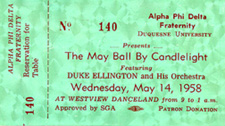 Do you recall how you first caught the jazz bug—that moment
or event that caused you to change your musical taste? For me, that
instant in time occurred in 1958, a period when I was deeply into
the then-underground sounds of Rhythm & Blues that were accessible
only on an independent, daylight station in my hometown of Pittsburgh,
PA or on hard-to-find 45s. Oh, I had heard several jazz albums in
an uncle's collection that included LPs of Chet Baker, Zoot Sims,
and Illinois Jacquet, but the music of The Moonglows, The Penguins,
The Crows, The Chords, Clyde McPhatter and the Drifters, and Hank
Ballard and The Midnighters still dominated my musical taste. I was
in college at the time at Duquesne University and my fraternity, Alpha
Phi Delta, promoted each year a formal ball with music by a name big
band. Groups led by Ralph Martieri, Richard Maltby, Warren Covington,
and Johnny Long were presented by us in the latter half of the 1950s.
However, in 1958, our social director learned from our booking agent,
Joe Hiller, that Duke Ellington would be playing in Chicago a day
or so before our event and was scheduled in New York shortly thereafter.
Since trains were the preferred mode of transportation then, Ellington
would be passing through Pittsburgh, and a reasonable deal could be
struck for him to play at our May Ball. Well, we made the contract,
and the resulting exposure to Ellington was all it took to make me
a livelong devotee to this music. Do you recall how you first caught the jazz bug—that moment
or event that caused you to change your musical taste? For me, that
instant in time occurred in 1958, a period when I was deeply into
the then-underground sounds of Rhythm & Blues that were accessible
only on an independent, daylight station in my hometown of Pittsburgh,
PA or on hard-to-find 45s. Oh, I had heard several jazz albums in
an uncle's collection that included LPs of Chet Baker, Zoot Sims,
and Illinois Jacquet, but the music of The Moonglows, The Penguins,
The Crows, The Chords, Clyde McPhatter and the Drifters, and Hank
Ballard and The Midnighters still dominated my musical taste. I was
in college at the time at Duquesne University and my fraternity, Alpha
Phi Delta, promoted each year a formal ball with music by a name big
band. Groups led by Ralph Martieri, Richard Maltby, Warren Covington,
and Johnny Long were presented by us in the latter half of the 1950s.
However, in 1958, our social director learned from our booking agent,
Joe Hiller, that Duke Ellington would be playing in Chicago a day
or so before our event and was scheduled in New York shortly thereafter.
Since trains were the preferred mode of transportation then, Ellington
would be passing through Pittsburgh, and a reasonable deal could be
struck for him to play at our May Ball. Well, we made the contract,
and the resulting exposure to Ellington was all it took to make me
a livelong devotee to this music.
We
had been promoting the event for weeks before his arrival by convincing
the owner of a popular college hangout to insert Ellington singles
into his juke box, and our group fed the machine constantly with
nickels to keep the sound of the Duke in the forefront. The event
was held at the Westview Danceland, a huge room in the center of
an amusement park complete with rotating crystal chandelier and ever-changing
light patterns.
The full Ellington band arrived with all the pomp and ceremony of
royalty. It included his entire troupe:
- Duke Ellington-Piano
- Johnny Hodges-Alto
- Paul Gonsalves-Tenor
- Cat Anderson-Trumpet
- Russell Procope-Clarinet
- Harry Carney-Baritone
- Jimmy Hamilton-Tenor
- Ray Nance-Violin
- Quentin Jackson-Trombone
- Clark Terry-Trumpet
- Willie Cook-Trumpet
- Jimmy Woode-Bass
- Britt Woodman-Trombone
- John Sanders-Trombone
- Sam Woodyard-Drums
- Velma Middleton-Vocals
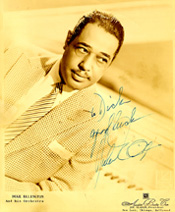 Ellington
was magical. He opened the early stages of the ball with very danceable
music as the crowd of around 500 couples graced the huge dance floor.
The music was overwhelming for me. The band hit dynamic highs with
emotional intensity, and the crowd was enthralled. Midway through
the ball, Ellington and the band put on a show where no one danced.
Everyone crowded around the stage to hear Ellington and all the famous
soloists strut their stuff. I recall a lengthy version of "Caravan"
as the highlight of the show. Johnny Hodges oozed out smooth, long-lined
riffs, Cat Anderson soared to heights I had never heard, and Russell
Procope made the clarinet do things clarinets were not supposed to
do. The tight ensemble playing crystallized everything they were saying.
If I could pinpoint one moment that turned my musical tastes around
forever, that was it. Although I was obviously not an astute student
of this music, the sounds simply captivated me. No formal understanding
of what they were doing was necessary. The Duke's music spoke and
I listened. It was pure communication. Ellington
was magical. He opened the early stages of the ball with very danceable
music as the crowd of around 500 couples graced the huge dance floor.
The music was overwhelming for me. The band hit dynamic highs with
emotional intensity, and the crowd was enthralled. Midway through
the ball, Ellington and the band put on a show where no one danced.
Everyone crowded around the stage to hear Ellington and all the famous
soloists strut their stuff. I recall a lengthy version of "Caravan"
as the highlight of the show. Johnny Hodges oozed out smooth, long-lined
riffs, Cat Anderson soared to heights I had never heard, and Russell
Procope made the clarinet do things clarinets were not supposed to
do. The tight ensemble playing crystallized everything they were saying.
If I could pinpoint one moment that turned my musical tastes around
forever, that was it. Although I was obviously not an astute student
of this music, the sounds simply captivated me. No formal understanding
of what they were doing was necessary. The Duke's music spoke and
I listened. It was pure communication.
 One
of the great moments happened at the end of the dance. I was the newly
elected treasurer of the fraternity, and so Ellington met with our
ball chairmen and me in a private room to settle our account. I vividly
remember writing a check payable to Duke Ellington for $2,500, which
in 1958 dollars was a lot of money for a group of college kids. Actually,
Ellington commanded $4,000 for a weekend show in 1958, but since this
was a mid-week stopover, we were able to strike a bargain. My only
regret is that I did not have my picture taken with the Duke, who
posed with the chairmen Ralph Martini and Dick Mellick. He even gave
Dick the signed glossy pictured above. One
of the great moments happened at the end of the dance. I was the newly
elected treasurer of the fraternity, and so Ellington met with our
ball chairmen and me in a private room to settle our account. I vividly
remember writing a check payable to Duke Ellington for $2,500, which
in 1958 dollars was a lot of money for a group of college kids. Actually,
Ellington commanded $4,000 for a weekend show in 1958, but since this
was a mid-week stopover, we were able to strike a bargain. My only
regret is that I did not have my picture taken with the Duke, who
posed with the chairmen Ralph Martini and Dick Mellick. He even gave
Dick the signed glossy pictured above.
After Ellington, I went on a quest to hear more of this music called
jazz. I purchased my first record player and started buying Horace
Silver, Cannonball Adderley, Thelonious Monk, Miles Davis, Ahmad Jamal,
and all the other greats who were easily available at record shops
throughout the city.
During the several years after the Ellington ball, I was able to catch
numerous live performances in Pittsburgh. At the Syria Mosque center
in the Oakland district, I saw in 1958:
Nina Simone Solo Performance. Her smoky voice and her infusion
of classical music with jazz were thrilling. At that time, she was
coming off her great hit "I Loves You Porgy".
Maynard
Ferguson Big Band. His brand of music was much removed from what
I heard Ellington do. His claim to fame in those days was the ultra-high
trumpet notes he was capable of hitting.
Ella Fitzgerald
& Orchestra. The band was not identified but the scatting of Ella
was the memorable part of the night.
Oscar Peterson Trio.
With Ray Brown on bass and Ed Thigpen on drums, the group simply known
as "The Trio" was a happy, pulsating band spewing out infectious rhythms
at a rapid pace.
Sonny Rollins Trio. This group really startled me. Rollins
had Henry Grimes on bass and Pete LaRoca on drums playing music that
was one of my earliest tastes of sounds breaking out of the conventional
mold.
In 1959, several great artists found their way to Pittsburgh,
including:
Chris Connor & Trio. Connor was the rage on campuses at this
time, and her sultry offering of "All About Ronnie" was a memorable
part of the evening.
Chico Hamilton Quintet. This drum master's group included Eric
Dolphy on reeds, (I was too much of a novice to realize the magnitude
of Dolphy at that time), Robert Haynes on bass, Nathan Gershman on
cello, and a guitarist I failed to document. Besides the obvious thrill
of seeing Hamilton, I most recall the strange but hauntingly beautiful
music that came from Gershman's cello, an instrument that seemed initially
at odds with jazz. He quickly dispelled that misconception.
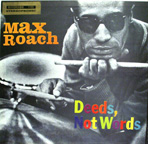 Max
Roach Quartet. Roach played with George Coleman on tenor, the
great trumpeter Booker Little, and Ray Draper on tuba. Roach's bombastic
style was the scene-stealer, although Little made a strong impression
on me. Draper's contributions on Deeds, Not Words were a startling
discovery for me, particularly the pulse he set on "You Stepped Out
of a Dream". Max
Roach Quartet. Roach played with George Coleman on tenor, the
great trumpeter Booker Little, and Ray Draper on tuba. Roach's bombastic
style was the scene-stealer, although Little made a strong impression
on me. Draper's contributions on Deeds, Not Words were a startling
discovery for me, particularly the pulse he set on "You Stepped Out
of a Dream".
I continued my jazz education in 1960 by becoming an aggressive
record collector. From the concert and club side, I saw:
Art Blakey & The Jazz Messengers. Blakey came equipped with
an all-star lineup of Wayne Shorter on tenor, Lee Morgan on trumpet,
Bobby Timmons on piano, and Jymie Merritt on bass. All I can say is—Wow!
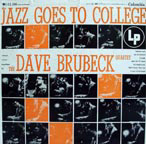 Dave
Brubeck Quartet. Brubeck was a seminal player in the jazz world
in those days. He performed at the Melody Tent with Paul Desmond on
alto, Gene Wright on bass, and Joe Morello on drums. To this day,
I still revert to Jazz Goes to College, which I mark as one
of the most essential records in my vast collection. Dave
Brubeck Quartet. Brubeck was a seminal player in the jazz world
in those days. He performed at the Melody Tent with Paul Desmond on
alto, Gene Wright on bass, and Joe Morello on drums. To this day,
I still revert to Jazz Goes to College, which I mark as one
of the most essential records in my vast collection.
Shirley Scott. This amazing organist gave a solo performance
at the famous Hurricane Bar in the Hill District of Pittsburgh. The
small stage sat above the bar, giving her a commanding presence which
she exploited with her funky sound.
Kai Winding Quintet. Winding was also a very popular name at
this time. He played a small room in suburban Pittsburgh, but unfortunately,
I do not remember the names of the others.
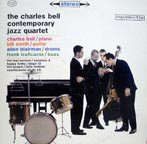 The
year 1961 was pivotal for me. I was exposed to a group led
by Pittsburgh pianist Charles Bell called the Contemporary Jazz Quartet.
Bell had won the Georgetown Intercollegiate Jazz Competition in 1958
and received a Columbia record date as his prize. I first met him
at a record store where he sold me the LP, The Contemporary Jazz
Quartet (he convinced me the stereo version, for an extra dollar,
was better). It simply blew me away. Downbeat gave it five stars (June
22, 1961, p. 26). Bell played a brand of jazz I had never heard before,
using complex and intricate movements with third-stream overtones
and incredible improvisations. His group had Bill Smith on guitar,
Allen Blairman on bass, and Frank Traficante on drums. Smith's ability
to weave in and around the dense piano playing was integral to the
group sound. I followed their gigs around Pittsburgh like a rock groupie,
catching them every opportunity I could. Bell turned me on to Cecil
Taylor (Looking Ahead with vibist Earl Griffith was my initial
splash), Ornette Coleman (I bought Free Jazz as my first taste),
and Eric Dolphy (his collaboration with Ken McIntyre on another LP
called Looking Ahead was my first recorded exposure). I was
a new-music fan forevermore. Bell released two other albums, but neither
reached the innovative heights of his Columbia release. He never became
a big-name star, but his influence was the dominant force in moving
me toward the new music. The
year 1961 was pivotal for me. I was exposed to a group led
by Pittsburgh pianist Charles Bell called the Contemporary Jazz Quartet.
Bell had won the Georgetown Intercollegiate Jazz Competition in 1958
and received a Columbia record date as his prize. I first met him
at a record store where he sold me the LP, The Contemporary Jazz
Quartet (he convinced me the stereo version, for an extra dollar,
was better). It simply blew me away. Downbeat gave it five stars (June
22, 1961, p. 26). Bell played a brand of jazz I had never heard before,
using complex and intricate movements with third-stream overtones
and incredible improvisations. His group had Bill Smith on guitar,
Allen Blairman on bass, and Frank Traficante on drums. Smith's ability
to weave in and around the dense piano playing was integral to the
group sound. I followed their gigs around Pittsburgh like a rock groupie,
catching them every opportunity I could. Bell turned me on to Cecil
Taylor (Looking Ahead with vibist Earl Griffith was my initial
splash), Ornette Coleman (I bought Free Jazz as my first taste),
and Eric Dolphy (his collaboration with Ken McIntyre on another LP
called Looking Ahead was my first recorded exposure). I was
a new-music fan forevermore. Bell released two other albums, but neither
reached the innovative heights of his Columbia release. He never became
a big-name star, but his influence was the dominant force in moving
me toward the new music.
New music in clubs or in concert form was not available to me in Pittsburgh
during 1961, but I did have the opportunity to see:
Ramsey Lewis Trio. Lewis was another 'name' in 1950s jazz.
With gentlemen Eldee Young on bass, and Red Holt on drums, he played
music that was totally at odds with what Charles Bell was doing. I
recall heavy discussions with Bell on the differences in these two
diverse styles of piano playing. Still, his Down to Earth recording
had its moments for this impressionable newcomer to the music.
 The
Mastersounds Trio. One of my great thrills was hearing and talking
with Wes Montgomery. His brothers Buddy and Monk were on the bill
with him. I owned his great Montgomeryland album with Harold
Land, but he told me he had moved beyond that point. During our conversation,
he excused himself and said he wanted to catch a new guitarist of
whom he had heard good things. This set at the Crawford Grill, also
in the Hill District, was just down the street from a bar called Mutt's
Hut, where Montgomery went to see the then-unknown guitarist George
Benson play. The
Mastersounds Trio. One of my great thrills was hearing and talking
with Wes Montgomery. His brothers Buddy and Monk were on the bill
with him. I owned his great Montgomeryland album with Harold
Land, but he told me he had moved beyond that point. During our conversation,
he excused himself and said he wanted to catch a new guitarist of
whom he had heard good things. This set at the Crawford Grill, also
in the Hill District, was just down the street from a bar called Mutt's
Hut, where Montgomery went to see the then-unknown guitarist George
Benson play.
Les McCann Trio. At the same Crawford Grill, I saw McCann with
Leroy Vinnegar on bass and Ron Jefferson on drums. McCann's The
Shout was a big seller at the time, and his blending of gospel
with his pounding ripples was a real crowd-pleaser.
I
was transferred by my employer away from Pittsburgh in 1962 and continued
my quest for jazz in other cities. The Pittsburgh jazz scene, however,
made an indelible impression on me that has never waned. The starting
point for it all, of course, was my exposure to the Duke Ellington
orchestra in 1958. I would guess that, had I not seen him at that
time, I would probably have found my way to jazz through other avenues
of exposure, but Ellington's music at the May Ball on that one special
night was the catalyst that put me on a musical path that to this
day dominates my life.
|
|
|
|
|

